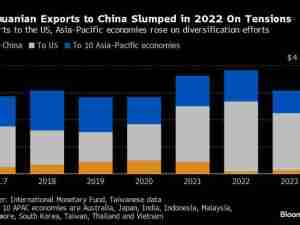The U.K.’s trade deficit widened to a record high in January as exports to the European Union plunged with an increase in red tape following Britain’s exit from the bloc.
Imports of goods excluding precious metals, which can be volatile, increased 11% in January, due to a surge in shipments from the EU, according to data released Friday by U.K. Office for National Statistics. Exports fell 8.7%, with sales to the EU down sharply.
It left the trade deficit at 21.9 billion pounds ($29 billion), the biggest shortfall since at least 1996.
“More traders experienced difficulties with paperwork on EU exports as 2021 went on, and in the early part of 2022,” said William Bain, head of trade policy at the British Chambers of Commerce. “This is having a major effect on trade.”
Still, the ONS said that about two-thirds of the 21% fall in exports to the EU was due to a change in methodology, which meant some goods sent to the bloc are now being recorded later, and will likely show up in the February figures.
“We’d be surprised if a lot of that move is not reversed in February,” said Paul Dales, chief U.K. economist at Capital Economics. “Even so, the bigger picture is that exports are still struggling to recover from Brexit and the pandemic.”
The ONS said the 24% rise in imports from the EU was deemed to be “genuine” trade, rather than the result of a shift to using customs declarations in January. Previously, the trade was captured using a survey.
Imports of cars rose strongly as a fall in domestic production spurred demand for vehicles from the EU, the ONS said.




